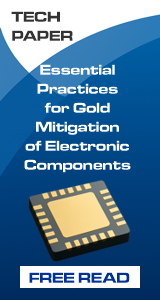|

|
|
|
|
Pad Cratering Susceptibility Testing with Acoustic Emission
Analysis Lab |
|
Authored By:Wong Boon San Agilent Technologies, Bayan Lepas, Malaysia Richard Nordstrom, Ph.D. Acoustic Technology Group, Grandville, MI USA Julie Silk Agilent Technologies, Santa Rosa, CA USA SummaryPad cratering test methods have been under development with the emergence of this laminate fracture defect mechanism. In additional to ball shear, ball pull, and pin pull testing methods, the acoustic emission method is being developed to evaluate laminate materials' resistance to pad cratering. Though the acoustic emission (AE) method has been proven to be able to detect pad cratering, no study has reported which AE parameters are good indicators for the susceptibility of PCB laminates to pad cratering. In this study, six different laminates subjected to three different pre-conditioning (multiple reflow) cycles have undergone the four-point bend testing. Four AE sensors were used to monitor pad cratering during the bend test. Several AE parameters including amplitude in dB level, the energy, and the location of each AE event under different load levels are recorded. Location analysis shows the majority of AE events are concentrated in the largest BGA package in the test vehicle, which indicates that pad cratering is elevated with the larger size of BGA package due to high stress concentration. Both the number of AE events and the cumulative energy of AE events at a given applied load show that Laminate F is prone to pad cratering. However, there is no statistically significant difference in the lowest applied load to detectable AE among these six laminates. The ranking of the six laminate materials is different using different test methods. The most effective test method for predicting pad cratering susceptibility is inconclusive from this study. ConclusionsPad cratering susceptibility of five Pb-free compatible laminates and one dicy-cure non-Pb-free-compatible laminate was evaluated using 4-point bend testing with acoustic emission. Cross-sectioning results confirm that the acoustic emission method is a viable tool to detect pad craters during the 4-point bend test. However, not all AE events are associated with pad cratering. Laminate cracks in locations away from the component or between layers are detected by the AE method. Location analysis shows the majority of AE events concentrate in the largest BGA package in the test vehicle. It indicates that pad cratering is elevated with the larger size of BGA package, which can be explained by the higher stress concentration under the pads of large BGAs than under the pads of small BGAs. Both the number of AE events and the cumulative energy of AE events at a given applied load indicates that Laminate F is prone to pad cratering, confirming our experience. However, there is no statistically significant difference in the lowest applied load to detectable AE among these six laminates. Thus, the lowest applied load to detectable AE may not be a good indicator for comparing laminates' resistance to pad cratering. It is recommended to use the number of AE events and the cumulative energy of AE events at a given applied load to evaluate laminates' resistance to pad cratering. The ranking of the six laminate materials is different among the pad-solder level tests, the drop test, and the 4-point bend test with acoustic emission. The most effective test method for predicting pad cratering susceptibility is inconclusive from this study. |
|
Comments
|
|
|
|

|


